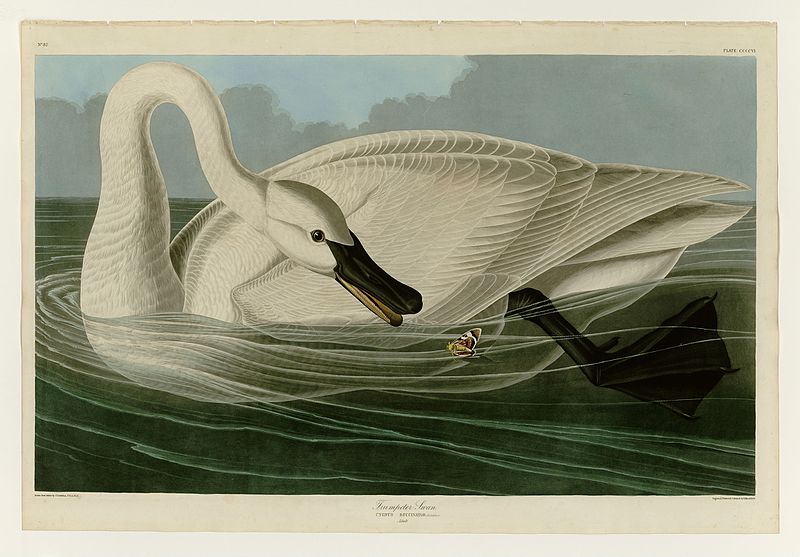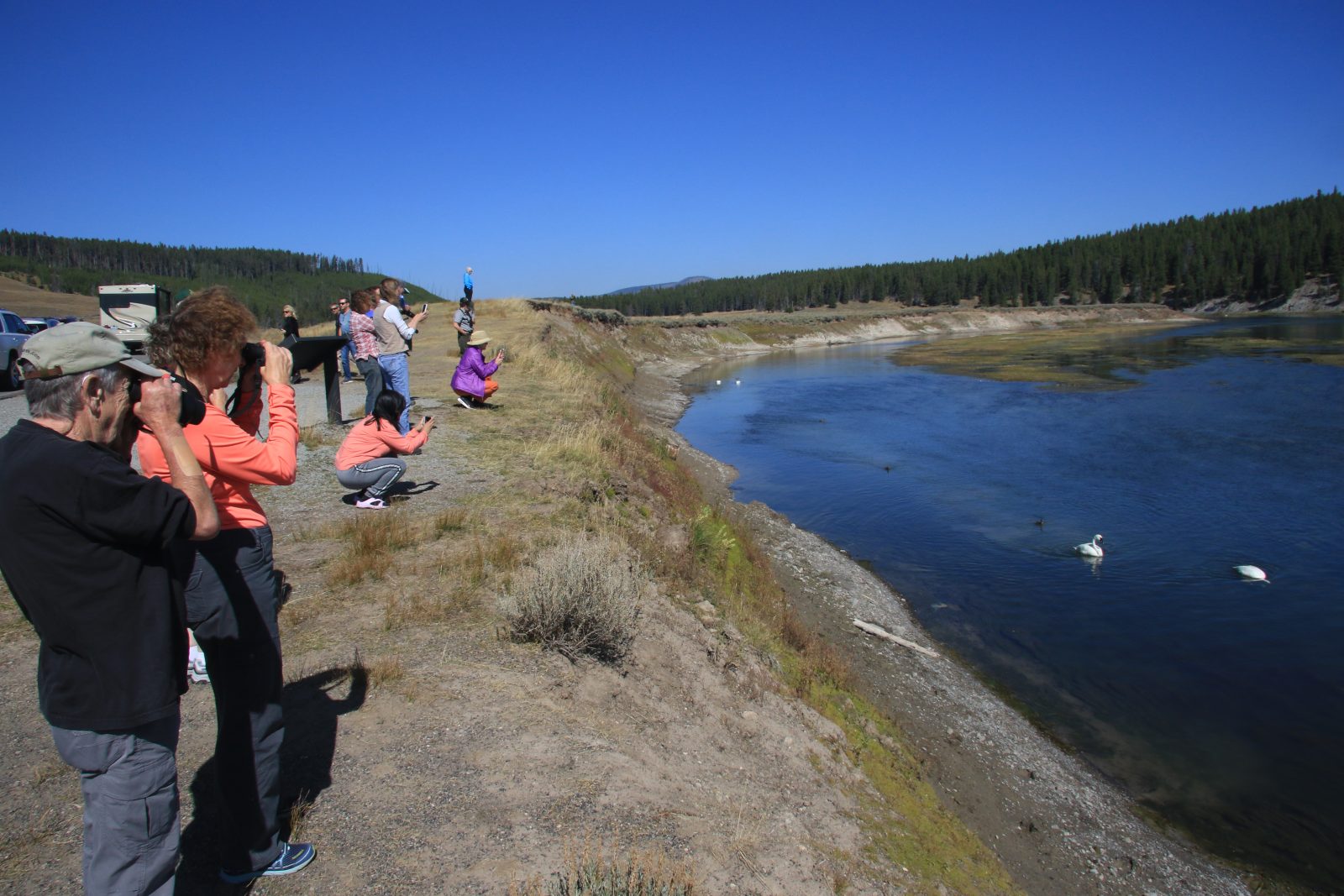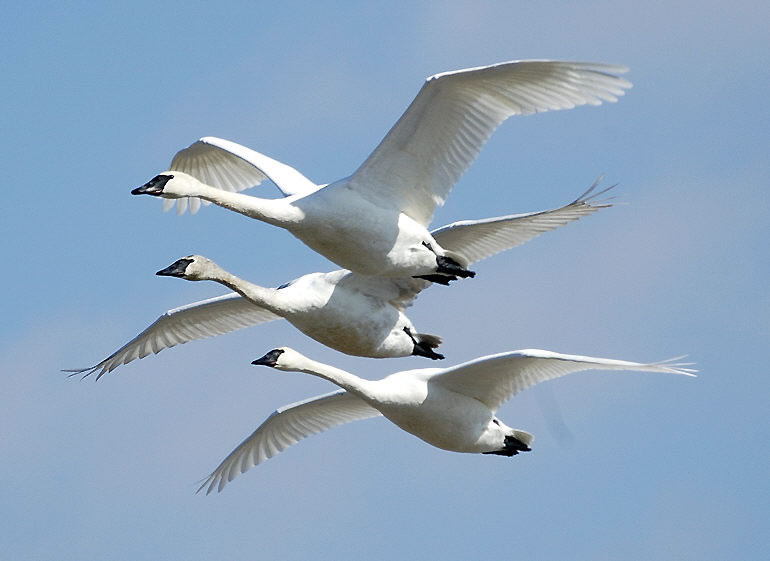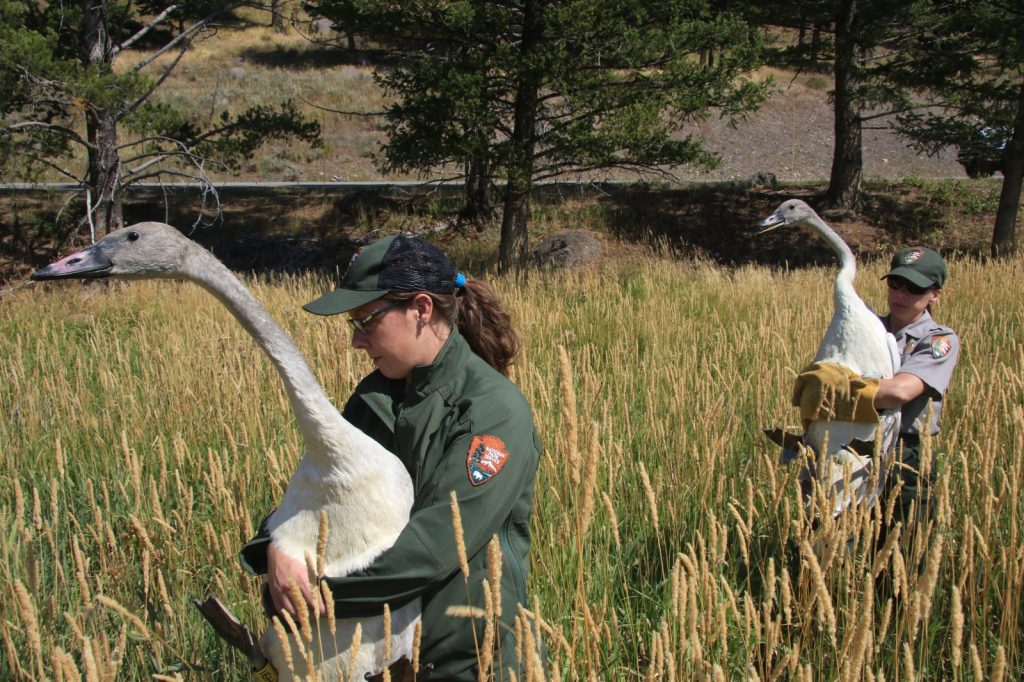In the early 1900s, when people were driving any birds with attractive plumage to extinction, a small group of trumpeter swans persisted, tucked away in a hidden corner of the U.S.
They had been killed off nearly everywhere else. Hunters wanted their meat. Women’s hat and clothing manufacturers wanted their striking white feathers.
But in Yellowstone National Park, the nearby Red Rock Lakes National Wildlife Refuge and surrounding region, about 70 birds remained. Now in a twist of ecological fate, what was once one of the last reservoirs of trumpeter swans in the lower 48 may blink out.
“I think it’s on one hand tragic and the other hand sad because you are losing a native species that used to do extremely well in Yellowstone,” says Doug Smith, senior wildlife biologist with Yellowstone National Park. “I get you can’t preserve vignettes of primitive nature forever because systems are constantly changing, but swans have been a vital part of the ecosystem.”
Smith has been tracking trumpeter swans in the Park since he was assigned the duty in 2008. They’re not his only charge – he was the lead biologist when grey wolves were reintroduced, he’s watched as grizzly bears have made a comeback, and he’s helped track epic elk migrations — but of the megafauna he studies and manages, the trumpeter swan is one of the most iconic, easiest to see and longest documented (records go back in the Park to 1917).
It’s also one of the most imperiled.
Only two breeding pairs exist in the Park now, and their finicky nature means many years they may simply choose not to reproduce, and they haven’t in the last two years.
“Right now, we’re not sure why swans are doing poorly,” Smith said. “We have some good ideas, but we can’t say it definitively. If we learn that Yellowstone has changed so much it’s no longer swan habitat, we have to bite the bullet and understand that.”
The Last Reserve
Like grizzly bears and bison, swans’ longevity in Yellowstone National Park was largely a product of its protected status. The Park was established in 1872 to protect its soaring geysers, psychedelic hot springs and complex thermal features. As a side effect, the wildlife in the park was also preserved.

Red Rock Lakes was set aside as a swan refuge in the 1930s, when officials realized it was one of the few remaining locations with the massive birds.
Once the country decided it was time to stop hunting swans and start protecting them – in the 1960s – about only a few thousand remained across the continent, according to the Trumpeter Swan Society. Outside of Yellowstone, Red Rock Lakes and a few other refuges, the rest lived in remote portions of Alaska and Canada.
Swans and their eggs were used to try to restore populations in the West as early as the late 1930s and 1940s. In the mid-1960s, reintroduction programs began in Minnesota, and by the 1980s and 1990s, they were being restored in earnest throughout portions of the Midwest and Rocky Mountains.
Some of the relocations have been successful, such as the Upper Green River area in southwest Wyoming which now has more than 25 breeding pairs of swans.
It’s considered an expansion area, a possible connection between Yellowstone at the farthest north, the Snake River population near Jackson, Wyoming and south to Green River, says Susan Patla, nongame biologist for the Wyoming Game and Fish Department.
But the Snake River population is still small – about nine breeding pairs – and faces competition for food from Canadian and Alaskan birds that come down to the warmer springs to winter.
“When you look at the total number of young, we had 43 young produced in the Green River compared to 14 in the Snake River,” Patla says. “If we didn’t have a range expansion program I would be much more worried about the Snake.”
About 60,000 swans exist throughout North America now, mostly centered in Alaska, the Rocky Mountains and the Midwest.
But back in Yellowstone, the place that kept the species alive, the birds are struggling.
“If you graph the swan population, each year it’s increasing or stable from ‘30s to the ‘60s,” Smith says. “In the ‘60s, the line starts to dip down and in the early ‘90s, it dips down steeper.”
Humans Predators and Climate Change
Why, exactly, swans in Yellowstone are suffering is largely open for debate among biologists. But most wildlife managers have narrowed it down to three likely suspects: eagle predation, human disturbance and climate change.

Eagle predation, which seems like the most natural impact on swans, is also a product of humans. Lake trout were illegally introduced into the Yellowstone ecosystem and eviscerated the native cutthroat population, meaning instead of feeding on thousands of cutthroats, eagles are targeting other food such as swan babies.
And their impact is exacerbated by human disturbance.
“People see the swans and walk to them and say, ‘Isn’t that cool, it’s a swan.’ The swans go ‘oh sh–,’ and they swim out into open water (away from protective cover on the shore) and the eagles dive bomb their young. I’ve seen it from the air.”
When a swan pair produces only two or three young every year, losing a portion takes a quick toll on the population.
The other main issue is climate change, which is creating colder, wetter springs and drier wetlands in the fall. Both of which kill swans.
“Almost their entire diet is submerged aquatic vegetation, not like geese that will also eat Kentucky blue grass,” says Patla. “A family of two to raise four cygnets to flight takes 3 to 5 tons of vegetation.”
As wetlands dry in the summer and fall, so does the food.
Variable weather in the spring also can kill cygnets.
“Our two territories have not had young either year because their Achilles heel, what they don’t like, are cool wet springs. We’ve had two cool wet springs in a row,” says Smith. “It seems counterintuitive: How do you have cool wet springs due to climate change and wetland reduction due to climate change, but we do. Once summer hits it doesn’t rain.”
A Case for Intervention
By 2010, only eight swans remained in Yellowstone, and Park Service officials had two options: supplement the population with more swans or let the species go.
“We intervened, and the reason we intervened is because until you can identify the direct cause, we don’t want to lose swans. And two, if the cause is human, we can intervene.”
Since the likely causes are eagle predation – which was ultimately a product of humans introducing lake trout – human disturbance and climate change, the Park Service felt like it could begin bringing swans in to supplement the population.

Now about 25 individuals live in the park, but there are still only two breeding pairs.
Service officials have closed access to one of the nesting sites throughout the summer to prevent human disturbance. Swans at the other site are more accustomed to people, Smith says, and eagles aren’t nesting nearby.
But now biologists like Smith wonder if the population can ever be sustained again without human intervention, which is another ethical dilemma.
“It’s relatively cheap, and so you could keep bringing swans in. But fundamentally, the National Park Service is about natural processes, about letting nature take care of itself, reducing the impacts of humans and letting those natural processes occur on their own. Artificially augmenting the swan population indefinitely goes against that philosophy. Look at wolves. We reintroduced them for two years and they’re on their own in perpetuity.”
Swans will likely persist in other parts of the country, say biologists like Patla. The Green River population in Wyoming has plateaued, but is still strong.
Whether or not they can continue to exist in Yellowstone is still a matter for debate. Smith and others will keep trying fixes like building floating nests to prevent them from being flooded, continue reducing human impacts and reintroduce birds – the Service just released eight swans in early September.
“We would enjoy Yellowstone less to lose this magnificent beautiful bird that was once so common. It would be a less interesting and enjoyable world, not to mention ecologically we would lose a key component of the ecosystem,” says Smith.
“Some would say you can’t keep everything the same forever, and good point, but we’re humans, and it’s up to us.”




Ten or twelve years ago, while backpacking the Ice Age Trail in Wisconsin, I was blessed to catch sight of a pair of trumpeter swans near a small remote lake. They were banded around their necks and they flew in beautiful syncranized loops calling out their loud sounds. It was unforgettable. Sure do hope this lovely species can survive.
As a kid spending summers at the summer range for my grandmother’s herefords at Antelope Basin, one of the sights was the Trumpeter swan pair on the lake there. They built raised nests in the marsh but often neglected their eggs and seemed to be distracted parents when they did have young.
It would seem logical, if there is an opportunity for a wildlife biologist to come to Yellowstone to study
the swans and help the Park staff evaluate the situation, which may have already been done. As pointed
out, things change but if the introduced fish were eliminated from the lake, then maybe that would be
a starting point, to stabilize the appropriate fish species that the swans prefer. Electroshock fishing has
been used in our local parks to do fish counts, but I don’t know how practical that would be in a large
lake. It might also be detrimental to other animals (turtles, amphibians, etc.) but might help. While I was
at the University of Maryland, we found that something as basic a trees and wetland plants were very
important to maintaining healthy trout streams in the area. In parks that is possible, but in housing developments, etc. , the precious land and water habitats for the state butterfly were destroyed by development. Restoring appropriate habitat is really difficult to do with all of the unknowns that
contribute to the ecosystem. I vote for continuing to study and introduce swans as they are such a
precious resource. While the other swan populations are holding steady or increasing slightly, it
could be a problem that is going to affect them, too, in the future. The question is why Yellowstone and what is different in the other areas where the swans are doing “ok”.
Fantastic article. Many thanks for the clarity.
I live in MN near Monticello, and if you need some swans the Monticello population has exploded over the last decade by a full 10 times. You should see the DNR and parks department with help. Also there is an show on Amazon.com called Queen&Country watch season 1 ep. 3 The Queen’s Possessions they talk about a duck virus that kills swans. Hope your swans come out better in the years to come.
And yet in Maryland, it is my understanding that the state government powers that be determined that there were too many swans in the Chesapeake Bay area, and follow a policy of “addling” the eggs in nests to prevent them from hatching. Very sad human behavior.
Hi Barbara,
Thanks for your comment. The swans being controlled in the Chesapeake Bay are mute swans, a non-native species that can damage wetland habitat and chase off native waterfowl species. The species in Yellowstone is the trumpeter swan, an endangered, native species.
Matt Miller
What about reducing the number of introduced fish and introducing the native fish back? Probably a complex tax if not impossible. I just thought I would ask.
Hi Danna,
You can read more about this effort here: https://blog.nature.org/2016/08/24/why-gill-nets-lake-yellowstone-cutthroat-trout-invasive-fish/
I’m broken-hearted to learn of the decline of Yellowstone’s Trumpeter swan. They have always been a peaceful and glorious sight in the Park. I hope some mehods to help them survive are taken soon. Thank you for your efforts!
I know from our experience here in Chincoteague National Wildlife refuge, that several of the
rangers and others who work with wildlife have long learned that “Swans drive other birds out”
and addle their eggs when they leave a nest, to keep them down to a pair – or at the most, two.
Do you have someone who was trained that way who believed it was a ranger’s duty to ‘
prevent swans from building up a presence? I know it took us 5 or 6 years to ever see a
Swan again, after the staff “protected” other ducks and beast, and the Swans out of local existance.
Hi Susan,
Thanks for your comment. The swans that have been present on Chincoteague are mute swans, a non-native species that can damage wetland habitat and indeed drive off native species.
There are 2 native swan species in North America. The trumpeter swan is endangered. Rangers have not harassed or damaged eggs of swans in Yellowstone.
Matt Miller
I remember with sheer delight the trumpeting calls of the trumpeter swans flying in for a majestic landing on a nearby lake in Yellowstone. This experience was a precious gift of Nature. I applaud all those dedicated people working to save these beautiful birds from their demise. Thank you.
Because of humans we are even destroying Yellowstone. I have never been there but want to go some day but it is very sad how different it will be than in the past. Beautiful animals have to stop disappearing in this ecosystem. Can’t something be done with the Lake trout. I heard because of them that eagles are killing a lot more than just the swans and that is very sad. If we can mess it up we have to be able to fix are mistake.
Nice to hear what Doug is up to. He likely wouldn’t remember me, I was the Lead Guide for Yellowstone Ecosystem Studies’ coyote/wolf study under Bob. Hello to Doug, keep up the great work! What would YNP be without you?
Christine, thank you for publishing this wonderful and powerful article. You educated people and if even one does something, it gives the swans a better chance.
A comment: Yellowstone National Park does not leave nature to nature. They are currently involved in the continued rounding up, sterilization experiments, and slaughter of our last wild, free, genetically pure bison, the last in our nation who live in Yellowstone National Park and must migrate into and out of the park to survive. Anything you can do to save the last Yellowstone wild bison before they are completely exterminated by APHIS, Montana DOL and YNP? Please help them and write about them before they are gone forever. Just one disease, for example, could wipe them all out. Please don’t edit or delete this.
Trumpeter swans have really taken off in Minnesota where we have a lake cabin. There are pairs breeding on most every suitable site in the lakes around us (the Tamarac National Wildlife Refuge) and throughout northwestern Minnesota. There are also many bald eagles, so I am slightly perplexed why the eagles in Yellowstone would be a prevailing factor in the swans decline there. We have been so encouraged to see the swans return to Minnesota. They are beautiful, intriguing and wild. I hope they continue to flourish there, and that the trend reverses somehow in Yellowstone. Thank you for the article.
What a wonderful article Christine Peterson wrote about Trumpeter Swans. I had no idea that their breeding was such a dilemma in Yellowstone. I’m very happy that so many educated Scientists, Park Rangers and others are keeping such a close eye on this problem with the swans which, as you say, are a very important part of our ecosystem. With important articles like this, more and more people will recognize this importance. Thank you for this wonderful, educational article.
Great work.Please continue to save our native species